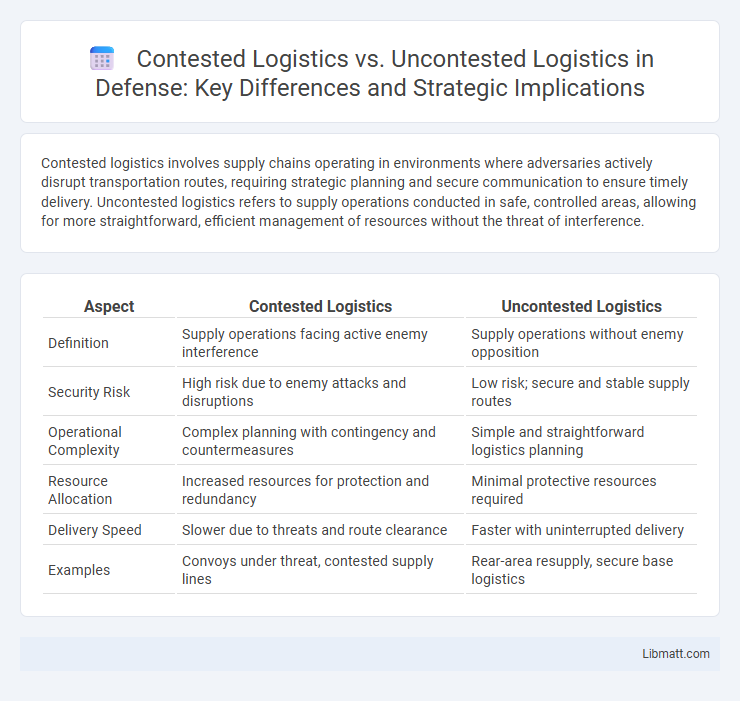Contested logistics involves supply chains operating in environments where adversaries actively disrupt transportation routes, requiring strategic planning and secure communication to ensure timely delivery. Uncontested logistics refers to supply operations conducted in safe, controlled areas, allowing for more straightforward, efficient management of resources without the threat of interference.
Table of Comparison
| Aspect | Contested Logistics | Uncontested Logistics |
|---|---|---|
| Definition | Supply operations facing active enemy interference | Supply operations without enemy opposition |
| Security Risk | High risk due to enemy attacks and disruptions | Low risk; secure and stable supply routes |
| Operational Complexity | Complex planning with contingency and countermeasures | Simple and straightforward logistics planning |
| Resource Allocation | Increased resources for protection and redundancy | Minimal protective resources required |
| Delivery Speed | Slower due to threats and route clearance | Faster with uninterrupted delivery |
| Examples | Convoys under threat, contested supply lines | Rear-area resupply, secure base logistics |
Understanding Contested vs Uncontested Logistics
Contested logistics involves the challenge of operating supply chains in hostile or denied environments where adversaries actively disrupt or target logistical operations, requiring advanced protection measures and adaptive strategies. Uncontested logistics occurs in secure environments with minimal threats, allowing for streamlined and predictable supply chain management. Understanding the distinction helps military and strategic planners develop appropriate risk mitigation and resource allocation to ensure operational effectiveness.
Key Differences Between Contested and Uncontested Logistics
Contested logistics involves operating in environments where adversaries actively disrupt supply chains through cyberattacks, physical attacks, or electronic warfare, requiring enhanced security measures and adaptive strategies. Uncontested logistics occurs in secure, stable environments with minimal threats, enabling more predictable and efficient supply chain operations without extensive countermeasures. The key differences lie in threat levels, operational complexity, and the need for resilience and rapid response in contested scenarios versus streamlined processes in uncontested settings.
Strategic Importance in Modern Supply Chains
Contested logistics involves supply chain operations conducted in environments with active threats, requiring robust risk management and adaptive strategies to ensure mission success. Uncontested logistics operate in secure settings, allowing smoother, more predictable distribution of goods and resources. Your strategic planning must account for these differences to maintain resilience and efficiency in modern supply chains.
Challenges and Risks in Contested Logistics
Contested logistics faces significant challenges such as disrupted supply lines, increased vulnerability to enemy attacks, and difficulty in maintaining secure communication channels, which complicate the timely delivery of critical resources. Risks include heightened exposure to cyber threats, physical interdiction by adversaries, and degradation of operational tempo due to unpredictable environmental conditions or hostile activity. Effective contested logistics requires adaptive strategies, robust intelligence, and resilient infrastructure to ensure mission success under adversarial pressure.
Advantages of Uncontested Logistics Environments
Uncontested logistics environments offer streamlined supply chains with reduced risks of disruption, allowing for faster and more reliable delivery of goods and services. These conditions enhance operational efficiency by minimizing security threats, interference, and the need for extensive resource allocation to protect logistics routes. Leveraging uncontested spaces also lowers costs associated with delays, damage, and rerouting, enabling organizations to maintain consistent inventory levels and optimize overall mission readiness.
Logistics Planning for Contested Scenarios
Logistics planning for contested scenarios requires robust strategies that anticipate disruptions from adversaries aiming to impede supply chains, unlike uncontested logistics where smooth flow is presumed. You must integrate redundancy, secure communication, and flexible transportation routes to maintain operational effectiveness under threat. Emphasizing concealment, rapid adaptability, and decentralized distribution ensures resilience against interference in contested environments.
Technological Solutions for Logistics Resilience
Technological solutions like autonomous delivery vehicles, drones, and blockchain-enabled supply chain management enhance logistics resilience in contested environments by providing secure, efficient, and adaptive transport options. In uncontested logistics, advanced analytics and IoT-driven real-time tracking optimize route planning and inventory management, improving operational efficiency. Implementing AI-powered predictive maintenance and cyber-defense mechanisms addresses disruptions in both contested and uncontested logistics scenarios.
Impact on Operational Efficiency and Security
Contested logistics faces significant challenges that degrade operational efficiency by increasing the risk of supply chain disruptions, delays, and resource shortages due to adversary interference or denied access to key routes. Uncontested logistics, by contrast, enable smoother, more predictable supply flows, ensuring timely delivery of critical materials and enhancing overall mission security and resilience. Your ability to maintain operational tempo and protect assets depends heavily on mastering logistics strategies tailored to contested or uncontested environments.
Case Studies: Contested vs Uncontested Logistics
Case studies of contested logistics reveal significant disruptions caused by enemy interference, as seen in the Battle of Stalingrad where supply lines were frequently targeted, leading to critical shortages and operational delays. In contrast, uncontested logistics during the Gulf War allowed coalition forces to maintain seamless supply chains, enabling rapid troop movements and sustained operations without significant hindrance. These examples highlight the importance of securing supply routes and adapting logistics strategies to the operational environment for mission success.
Future Trends in Logistics Environments
Future trends in contested logistics emphasize resilient supply chains utilizing autonomous systems, AI-driven threat detection, and decentralized distribution to overcome adversarial disruptions. Uncontested logistics environments prioritize efficiency through advanced robotics, predictive analytics, and seamless integration of Internet of Things (IoT) devices for real-time asset tracking. Both scenarios increasingly rely on digital twins and blockchain technology to enhance transparency, security, and adaptability in dynamic operational contexts.
Contested logistics vs Uncontested logistics Infographic

 libmatt.com
libmatt.com